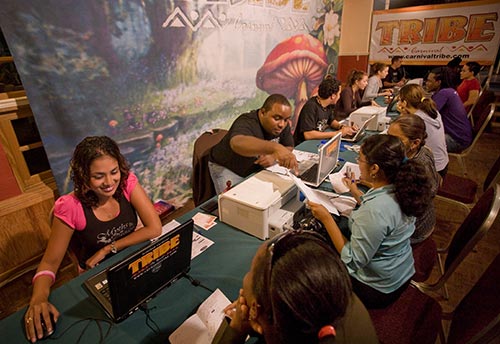BitDepth 605 - December 03
07/01/09 19:26 Filed in: BitDepth - December 2007
Tribe uses technology to manage its members and keep them well cared for during Carnival.
Bits behind the bacchanal

Hopeful Tribe masqueraders are guided through the registration process at Cascadia Hotel on August 23. Photography by Mark Lyndersay.
The crowd outside the Cascadia Hotel is surprisingly well-behaved. There are hundreds of young (and a few not so young) people here, some huddled under a tent pitched in the hotel's car park, most standing in the kind of anticipatory crowd semi-circle that keeps everyone with one eye on what happens next.
Upstairs, in a room normally reserved for executive meetings, there is a large television showing a continuous advertising loop to another large group of young patrons. The room is abuzz with excited chatter, the only drinks available are a large cooler packed with ice and bottled water, free for the taking.
It isn't until you go through the third door that you find out why this huge crowd is being so polite. In that room, demarcated into three zones of activity, is an efficient engine of registration that's moving dozens of people through the process of registering for Tribe.
Now Tribe is a large band, one of those uniquely Trinidadian phenomena that happens when very large groups of people decide to pursue a single thing with relentless determination. The band on the road is almost beyond description, a brigade of wining flesh supported by rolling refreshments and a platoon of jersey clad security patrolling the party perimeter.
Keeping the tribe in order
Keeping such a band in order requires organisation, and nowhere is it more evident than here, as dozens of Tribe workers sit behind networked laptop computers, reducing the passion of this crowd to keystrokes in a database.
 The database is Tribe's secret weapon in the high stakes game of Carnival bands, where a fickle crowd can end a bandleader's career with startling speed. Keeping young, soca driven aesthetes in the camp requires care and attention. Knowing who your masqueraders are in fine detail is a pretty good start.The man behind this feat of technology wouldn't draw much attention in a Tribe crowd. Angél Stewart (pronounced ahn-jel) is the Managing director of Sugar Islands.com and he has been handling technology for the band since their 2006 production.
The database is Tribe's secret weapon in the high stakes game of Carnival bands, where a fickle crowd can end a bandleader's career with startling speed. Keeping young, soca driven aesthetes in the camp requires care and attention. Knowing who your masqueraders are in fine detail is a pretty good start.The man behind this feat of technology wouldn't draw much attention in a Tribe crowd. Angél Stewart (pronounced ahn-jel) is the Managing director of Sugar Islands.com and he has been handling technology for the band since their 2006 production.
The most public indication of Stewart's work is Tribe's website, a staggeringly ornate Flash-based extravaganza that features full motion video of models wearing sample costumes. But it's the less exciting stuff going on behind the scenes that really drives the band's success.
"We started building Tribe's systems based on their previous experience, which was 150 people using their online form to register," Stewart said.
"On registration day, 3,000 people tried to use the form on their website in 30 minutes. That's when we knew that we had to rethink this client's needs. We redeveloped the system overnight and basically took it to enterprise capabilities."
Since 2005, the band has integrated Stewart's work more and more into its management of a massive customer base.
"What makes the difference for us," said Gerard Ramirez, the band's Director of Operations, "is the ease with which we can get information. Being able to access and collate data like people's sizes and meal preferences makes a big difference in planning for a more comprehensive all-inclusive experience."
Tribe's system is web-based and on registration day, the dozens of workers taking customer information were actually only facilitating a process that was taking place simultaneously on the Internet.
Up, up and away...
While those crowds were patiently awaiting their chance to sign up for Tribe, anyone with a credit card could have been doing the same thing on the Internet from anywhere else in the world.
"We keep two inventories," said Ramirez. "One for online and one for walk-in customers and we can change the ratio dynamically. This year, 35 percent of the costumes went to online sales. Some people arrived at registration, saw the crowds and went home to register online. We set aside a week for registration, but we were sold out in five days."
The phalanx of registration facilitators sat behind tables arranged in a large U shape working at wirelessly networked laptops that fed fresh and updated registration information into Tribe's Microsoft SQL database.
That data is at the core of the Carnival band's efficiency. Each customer has a unique ID, one that appears on previous masqueraders' customer loyalty cards that ties sales information such as payment status to body measurements to the specific box on racked shelving at the back of the mas camp that's handed to band members on distribution day.
Eventually, this information will be embedded in the magnetic stripe on the cards, and a single swipe at a terminal will be all that's required to pull that information up on a computer screen.
It's like the Superman story in reverse, the garish colours are Tribe's day to day identity, but when it's time to go to work, the band dons a suit and glasses to become a supernerd, tapping into a growing 7,000 entry strong customer relations management database that allows the band to soar above its peers.
Interested in more on this story? Read more here.

Hopeful Tribe masqueraders are guided through the registration process at Cascadia Hotel on August 23. Photography by Mark Lyndersay.
The crowd outside the Cascadia Hotel is surprisingly well-behaved. There are hundreds of young (and a few not so young) people here, some huddled under a tent pitched in the hotel's car park, most standing in the kind of anticipatory crowd semi-circle that keeps everyone with one eye on what happens next.
Upstairs, in a room normally reserved for executive meetings, there is a large television showing a continuous advertising loop to another large group of young patrons. The room is abuzz with excited chatter, the only drinks available are a large cooler packed with ice and bottled water, free for the taking.
It isn't until you go through the third door that you find out why this huge crowd is being so polite. In that room, demarcated into three zones of activity, is an efficient engine of registration that's moving dozens of people through the process of registering for Tribe.
Now Tribe is a large band, one of those uniquely Trinidadian phenomena that happens when very large groups of people decide to pursue a single thing with relentless determination. The band on the road is almost beyond description, a brigade of wining flesh supported by rolling refreshments and a platoon of jersey clad security patrolling the party perimeter.
Keeping the tribe in order
Keeping such a band in order requires organisation, and nowhere is it more evident than here, as dozens of Tribe workers sit behind networked laptop computers, reducing the passion of this crowd to keystrokes in a database.

The most public indication of Stewart's work is Tribe's website, a staggeringly ornate Flash-based extravaganza that features full motion video of models wearing sample costumes. But it's the less exciting stuff going on behind the scenes that really drives the band's success.
"We started building Tribe's systems based on their previous experience, which was 150 people using their online form to register," Stewart said.
"On registration day, 3,000 people tried to use the form on their website in 30 minutes. That's when we knew that we had to rethink this client's needs. We redeveloped the system overnight and basically took it to enterprise capabilities."
Since 2005, the band has integrated Stewart's work more and more into its management of a massive customer base.
"What makes the difference for us," said Gerard Ramirez, the band's Director of Operations, "is the ease with which we can get information. Being able to access and collate data like people's sizes and meal preferences makes a big difference in planning for a more comprehensive all-inclusive experience."
Tribe's system is web-based and on registration day, the dozens of workers taking customer information were actually only facilitating a process that was taking place simultaneously on the Internet.
Up, up and away...
While those crowds were patiently awaiting their chance to sign up for Tribe, anyone with a credit card could have been doing the same thing on the Internet from anywhere else in the world.
"We keep two inventories," said Ramirez. "One for online and one for walk-in customers and we can change the ratio dynamically. This year, 35 percent of the costumes went to online sales. Some people arrived at registration, saw the crowds and went home to register online. We set aside a week for registration, but we were sold out in five days."
The phalanx of registration facilitators sat behind tables arranged in a large U shape working at wirelessly networked laptops that fed fresh and updated registration information into Tribe's Microsoft SQL database.
That data is at the core of the Carnival band's efficiency. Each customer has a unique ID, one that appears on previous masqueraders' customer loyalty cards that ties sales information such as payment status to body measurements to the specific box on racked shelving at the back of the mas camp that's handed to band members on distribution day.
Eventually, this information will be embedded in the magnetic stripe on the cards, and a single swipe at a terminal will be all that's required to pull that information up on a computer screen.
It's like the Superman story in reverse, the garish colours are Tribe's day to day identity, but when it's time to go to work, the band dons a suit and glasses to become a supernerd, tapping into a growing 7,000 entry strong customer relations management database that allows the band to soar above its peers.
Interested in more on this story? Read more here.
blog comments powered by Disqus

